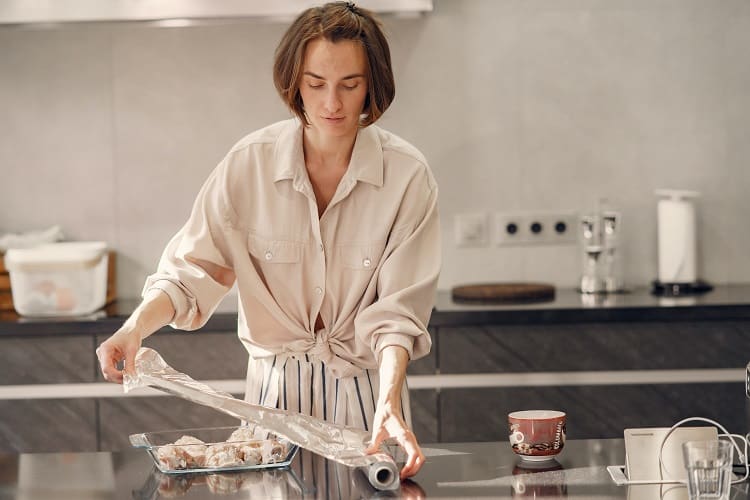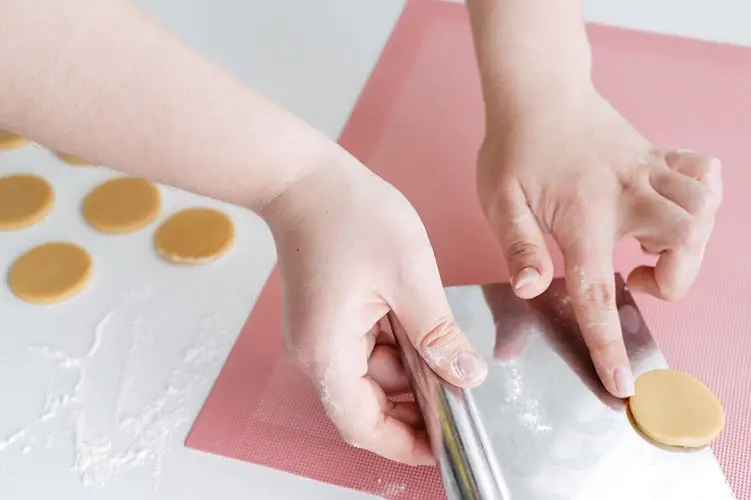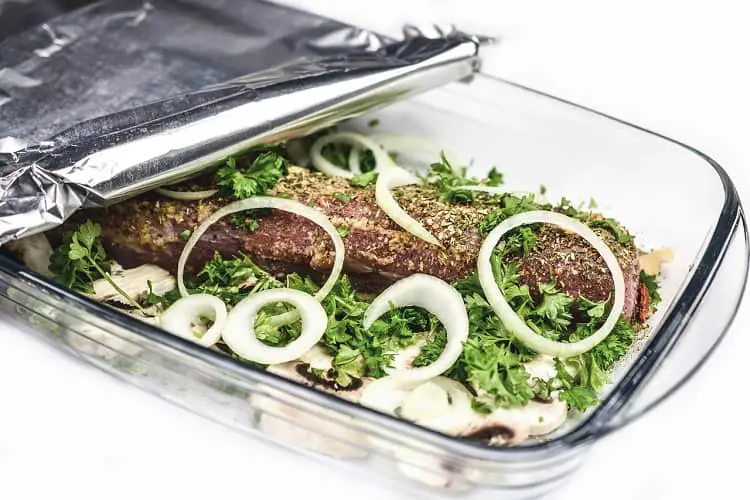Are you a kitchen wizard who loves to experiment with different cooking methods? If so, you might wonder, can you put aluminum foil in the oven? The short answer is yes, you can put aluminum foil in the oven, but with some important caveats. In this article, we’ll look at the pros and cons of using aluminum foil in the oven, including how it can affect cooking times, potential safety concerns, and more.
Aluminum foil is ubiquitous in most kitchens, often used for wrapping leftovers or lining baking sheets. While aluminum foil can be helpful in your cooking and baking tasks, it is more accessible and more efficient.
Whether you’re lining baking sheets, covering dishes, or using disposable baking trays, aluminum foil has got you covered.
We’ll also provide some helpful tips on using aluminum foil safely and effectively in the oven.
Can You Put Aluminum Foil In The Oven?
How to use aluminum foil in your oven

How To Clean An Oven With Baking Soda And Vinegar
Aluminum foil is a versatile kitchen essential that can make cooking and cleanup a breeze. It is perfectly safe to use in the oven and can help transmit heat evenly to your food.
In fact, aluminum foil is more flexible and durable than tin foil and can withstand high baking temperatures. When it comes to using aluminum foil in your oven, there are several handy tricks you can employ.
Covering baking sheet and Oven rack
If you want to avoid the hassle of cleaning grease from your baking containers, you’d better line your container with foil.
This prevents your food from coming into direct contact with the baking container or oven rack.
Aluminum foil is pretty delicate, so be careful when using it to prevent tears.
By placing it in the oven rack or the baking tray, you prevent spillages, thus keeping your Oven clean.
Wrapping food
If you are a fan of cooking and love watching cooking channels, you’ve probably noticed that many chefs use aluminum foil to wrap their foods, such as meat and vegetables.
This helps in preserving moisture, allowing the food to cook well.
However, you have to wrap your food very carefully and handle the foil gently as it can tear, causing spillage, which you are trying to avoid.
To ensure that the aluminum foil does not tear, do the following:
- Do not wrap acidic foods, such as tomatoes, with aluminum foils as they can react, thus altering their taste.
- If you want to bake tomatoes, ensure that you place parchment paper on the inner side of the foil.
This ensures that they do not come into contact with the foil.
It’s also the best way of ensuring that your oven is protected from chemical reactions.
For lining baking sheets and pans
Aluminum foil is the way to go for lining baking sheets and pans. Once your cookies, bread, or other baked goods are done, simply lift the foil from the pan and toss it away.
It’s that easy! And don’t worry about which side is up – the shiny and dull sides are just a result of the manufacturing process. However, if you’re using non-stick aluminum foil, make sure the dull side is facing up when baking stickier food.
Covering baking trays/dish
Looking to keep your dishes moist and tender? Cover them with aluminum foil during baking. By tenting or loosely placing foil over the dish, you can prevent the top from browning too quickly while the rest of the dish continues to cook. If you want to create more steam, tightly sealing the dish with a foil lid will do the trick.
Disposable aluminum baking trays and pans
Don’t have any metal dishes on hand? No problem! Disposable aluminum baking trays and pans can be a convenient alternative. They can handle high temperatures and quickly transmit heat, making them a reliable choice for baking.
Why Can’t I Use Aluminum Foil As An Oven Liner?

Using aluminum foil as an oven liner is not recommended because it can pose several safety risks. Here are a few reasons why:
- Fire hazard: Aluminum foil can easily trap heat and cause a fire. If it comes into contact with the heating element at the bottom of your oven, it can ignite and start a fire.
- Damage to the oven: The reflective surface of aluminum foil can reflect heat into the oven and cause damage to the heating element or other parts of the oven.
- Poor air circulation: Using aluminum foil as an oven liner can restrict air circulation, affecting your food’s cooking time and temperature. This can cause uneven cooking and potentially lead to foodborne illness.
- Chemical reaction: If acidic foods come into contact with aluminum foil, it can cause a chemical reaction that can transfer aluminum to your food. Consuming too much aluminum can harm your health, especially for people with kidney problems.
- Uneven heat distribution: Aluminum foil can also cause uneven heat distribution in the oven. Since it reflects heat, it can create hot spots in some areas of the oven and cool spots in others. This can result in unevenly cooked food.
- Electrical hazard: If aluminum foil comes into contact with the electrical components of your oven, it can cause a short circuit or damage to the oven’s electrical system. This can result in a safety hazard and expensive repairs.
- Difficulty cleaning: Using aluminum foil as an oven liner can be difficult. The foil can become stuck to the bottom of the oven, making it challenging to remove. This can result in leftover debris and grease harboring bacteria, leading to foodborne illness.
- Environmental impact: Using aluminum foil as an oven liner creates unnecessary waste. The foil cannot be recycled if it comes into contact with food, so it will end up in a landfill. This can contribute to environmental pollution and harm wildlife.
Overall, it is best to avoid using aluminum foil as an oven liner and opt for safer alternatives. If you are unsure what materials are safe for your oven, consult the manufacturer’s instructions or a professional.
Why Can You Put Aluminum Foil In The Oven But Not The Microwave?
The reason why you can put aluminum foil in the oven but not the microwave is because of the way each appliance works.
In an oven, the heat comes from the heating elements at the top or bottom of the oven, which radiate heat throughout the cavity. Aluminum foil reflects heat, so when used in the oven, it can help distribute heat more evenly and protect food from overcooking. As long as the aluminum foil is used correctly and does not come into direct contact with the heating elements, it is safe to use in the oven.
In a microwave, the heat is generated by the microwave radiation that passes through the food and causes the water molecules to vibrate, generating heat and cooking the food. However, aluminum foil in a microwave can reflect the microwaves, causing them to bounce off and potentially damage the microwave or start a fire.
Additionally, suppose the aluminum foil has any sharp edges or points. In that case, they can cause electrical arcing (sparks) when exposed to microwaves, damaging the microwave or starting a fire.
Therefore, it is not safe to use aluminum foil in the microwave. It is vital to use microwave-safe containers and follow the manufacturer’s instructions to ensure safe and efficient cooking.
House Cleaning Secrets Step-By-Step Guide
Which Side of the Aluminum Foil Should I Use?
When using aluminum foil, you may wonder which side of the foil should be facing outwards.
The truth is that both sides of the aluminum foil are equally effective for cooking, grilling, or baking.
Aluminum foil is made by rolling large aluminum sheets until they are thin and pliable.
During this process, the aluminum may come into contact with rollers or other surfaces, leaving marks on one side of the foil.
These marks do not affect the performance of the foil.
Therefore, you can use either side of the aluminum foil for cooking, grilling, or baking without any difference in the results.
However, some manufacturers may mark one side of the foil to help distinguish it from the other.
In this case, follow the manufacturer’s instructions and use the marked side facing outwards.
However, there is no right or wrong side when using aluminum foil for cooking, grilling, or baking. You can use either side of the foil without any impact on the cooking process or food quality.
What are Some Alternatives to Aluminum Foil?
- Parchment paper: Parchment paper is an excellent alternative to aluminum foil for baking, roasting, or wrapping food. It is non-stick, heat-resistant, and releases no chemicals when heated.
- Silicone baking mats: Silicone baking mats are another alternative to aluminum foil. They are non-stick, reusable, and can withstand high temperatures.
- Glass containers: Glass containers can store food in the fridge or freezer. They are non-reactive and do not release any chemicals or flavors into the food.
- Stainless steel containers: Stainless steel containers can also store food. They are durable, non-reactive, and can be used in the oven or stove.
- Beeswax wraps: Beeswax wraps are a natural alternative to plastic wrap or aluminum foil for wrapping food. They are made from cotton fabric coated with beeswax, which makes them reusable, washable, and compostable.
- Banana leaves: Banana leaves are commonly used in many cuisines as a natural wrap for cooking or serving food. They are biodegradable, impart a subtle flavor to the food, and can be composted after use.
- Cloth napkins or towels: Cloth napkins or towels can cover food or wrap sandwiches instead of aluminum foil. They are washable, reusable, and come in various colors and patterns.
- Cast iron pans: Cast iron pans can be used for cooking and baking instead of aluminum foil. They are durable, heat-resistant, and distribute heat evenly.
- Mason jars: Mason jars can store food or drinks in the fridge or freezer. They are glass, so they are non-reactive and do not release any chemicals into the food.
- Stainless steel or silicone baking dishes: Stainless steel or silicone baking dishes can be used for baking instead of aluminum foil. They are durable, non-reactive, and can be reused repeatedly.
- Reusable silicone food bags: Reusable silicone food bags can be used to store food instead of plastic wrap or aluminum foil. They are leak-proof, easy to clean, and can be used in the fridge, freezer, or microwave.
- Clay pots: Clay pots can be used for cooking and baking instead of aluminum foil. They are porous, which allows the food to cook evenly and retain moisture.
What are the Pros and Cons of Using Aluminum Foil in the Oven?

Benefits of using aluminum foil in the Oven:
- It helps you keep the Oven clean as it protects it from liquid and food particle spillage.
- You can use aluminum foil to retain moisture in the food, especially when grilling meat and vegetables.
- Since aluminum foil does not get hot like other baking trays, you do not need to use oven mitts to remove it from the oven.
- You do not need baking trays or sheets as long as you have aluminum foil.
- Aluminum foils allow you to cook food without using baking trays or a pan. This is because you can place your food directly on the foil, except for acidic foods.
Despite the many benefits, it’s still best to cook using baking trays as they are better than foil.
The disadvantages of using aluminum in the Oven:
- The aluminum foil may leach into your food and increase the amount of aluminum in your body, putting you at a health risk.
- If the foil sticks to the surface of the Oven, it can be challenging to clean, potentially damaging your Oven.
- It is very delicate, thus susceptible to tear, leading to spillage.
- Unless you use non-stick aluminum foil, the common one will require you to use grease or oil.
- It can lead to uneven cooking of food when placed incorrectly.
- Not ideal for acidic foods.
- Covering up vent openings at the bottom of the oven can lead to insufficient airflow, heat distribution, and performance issues.
- Heat reflecting off aluminum foil can overcook foods or damage your Oven’s heating elements.
- Lining your gas oven with aluminum foil can block heat and airflow and produce less-than-optimal cooking results.
- Aluminum foil can cause scratching of the Oven’s enamel surfaces.
Final Thoughts on Can You Put Aluminum Foil In The Oven?
In conclusion, aluminum foil is generally safe in the oven if used correctly and according to the manufacturer’s instructions.
Aluminum foil can help distribute heat more evenly and protect food from overcooking in the oven, but it should not be used as a permanent oven liner.
It is essential to avoid direct contact with heating elements and use caution when handling the foil to prevent injury or damage to the oven.
However, using aluminum foil in the microwave is unsafe as it can reflect microwaves and potentially damage the microwave or start a fire.
It is vital to use microwave-safe containers and follow the manufacturer’s instructions to ensure safe and efficient cooking.
Overall, while aluminum foil can be a helpful tool in the kitchen, it is essential to use it responsibly and follow all safety guidelines to prevent appliance accidents or damage.
I hope this article further enhances your knowledge of using and not using aluminum foil in the Oven.
